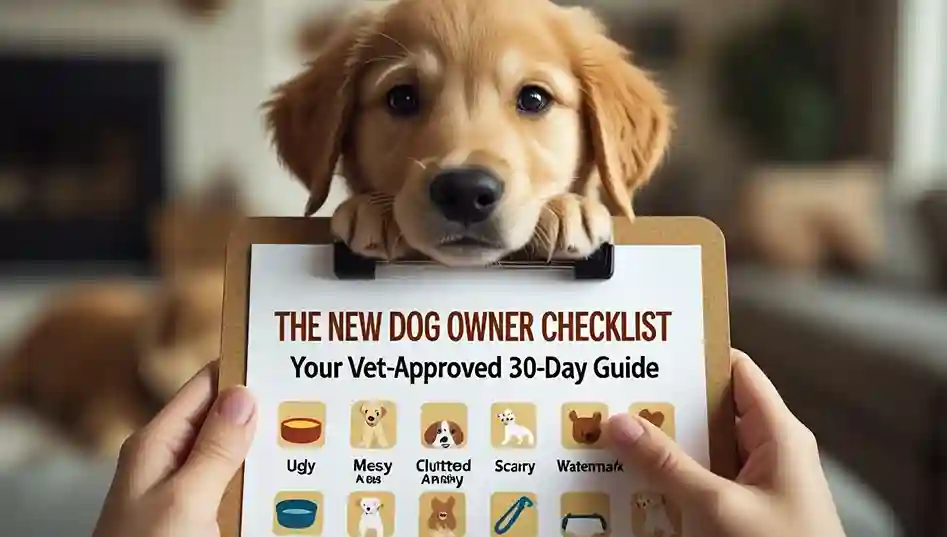That warm, wet, and sometimes slobbery sensation on your skin is a universal dog owner experience. But have you ever stopped to wonder, why do dogs lick you? While it’s often a sign of affection, this common behavior is a complex form of canine communication with multiple potential meanings. Understanding the true reason behind the lick is a fundamental part of decoding the messages outlined in our broader guide to understanding dog behavior.
Is it love, a request, a sign of stress, or something else entirely? This vet-reviewed guide breaks down the seven surprising reasons behind this behavior, helping you distinguish a happy greeting from a potential cry for help. We’ll explore everything from instinct and taste to anxiety and medical issues.
Stop guessing and start understanding. Let’s decode the secret language behind your dog’s licks.
Key Takeaways: Why Do Dogs Lick You
Before we explore the detailed reasons, here are the essential facts every dog owner should know about licking behavior.
- 💖 Multiple Meanings: Licking isn’t just about affection – it can signal communication, submission, curiosity, or even medical issues.
- 🐶 Natural Instinct: Puppies lick their mothers for food and comfort, and this nurturing behavior continues into adulthood as a social gesture.
- 👅 Taste & Exploration: Your skin carries salt from sweat and food residues, making you interesting to your dog’s sensitive taste buds.
- 🗣️ Communication Tool: Licking can be your dog’s way of saying “I love you,” “I’m hungry,” or “Please pay attention to me.”
- ⚠️ Know the Signs: While usually harmless, excessive licking can indicate anxiety, pain, or underlying health problems needing veterinary attention.
“At a Glance” Comparison Table: Types of Dog Licking
| Licking Type | Typical Meaning | Body Language Cues |
|---|---|---|
| Affectionate Licking | Bonding, greeting, showing love | Relaxed body, soft eyes, wagging tail, “smiling” mouth. |
| Submissive Licking | Respect, deference to pack leader | Lowered body, ears back, avoiding direct eye contact, tail tucked. |
| Attention-Seeking Licking | “Play with me!” or “Feed me!” | Pawing, bringing toys, persistent nudging, following you. |
| Anxiety Licking | Self-soothing during stress | Pacing, whining, pinned ears, tense body, panting. |
| Medical Licking | Pain relief or discomfort | Focused on one area, obsessive, accompanied by limping or hiding. |
The 7 Main Reasons Dogs Lick Humans
Understanding the motivation behind your dog’s licking helps you respond appropriately and strengthen your bond. Here are the most common reasons for this behavior.
Affection & Bonding: The “I Love You” Lick
Licking releases endorphins in your dog’s brain, creating feelings of pleasure and comfort. When your dog licks you with a relaxed body and soft eyes, they’re often expressing affection and strengthening your social bond, much like grooming behavior in wild canines.
Communication: Asking for Food or Attention
Your dog quickly learns that licking gets results. If they lick you while you’re eating or when you walk in the door, they’re likely communicating a specific request – usually for food, play, or your attention. This learned behavior is reinforced when it successfully gets them what they want.
Submission & Respect: Recognizing Your Leadership
In canine social structures, subordinate dogs often lick more dominant pack members as a gesture of respect and deference. If your dog licks you when you give a command or during tense moments, they may be acknowledging your leadership role in the household.
Exploration: Tasting Your Skin’s Salt & Scent
Your skin carries salt from sweat, microscopic food particles, and unique scent markers. Dogs explore the world through taste and smell, and your skin provides fascinating sensory information about where you’ve been and what you’ve been doing.
Comfort & Self-Soothing: Canine Stress Relief
Repetitive licking can be a coping mechanism for anxious dogs. The rhythmic motion releases calming endorphins, similar to how some people bite their nails or twirl their hair when nervous. Context is key here – look for other stress signals like pacing or whining.
Puppy Habits: Carryover from Motherly Care
Puppies lick their mother’s face to stimulate regurgitation and show submission. This early nurturing behavior often carries into adulthood as a social greeting and bonding mechanism with their human family members.
Medical Causes: When Licking Signals Health Issues
Sometimes excessive licking indicates underlying health problems. Gastrointestinal issues, dental pain, skin allergies, or nausea can all manifest as increased licking behavior. If the licking is obsessive or accompanied by other symptoms, consult your veterinarian.
Understanding Different Licking Contexts
The meaning behind your dog’s licking can change depending on the situation and where they’re licking you. Here’s how to interpret different licking scenarios.
Face Licking vs. Hand Licking vs. Constant Licking
Face licking often stems from puppyhood behavior – puppies lick their mother’s face to solicit food. In adult dogs, it’s typically an affectionate greeting. Hand licking is usually attention-seeking or taste-related (your hands carry food scents). Constant licking that seems obsessive, whether directed at you or objects, may indicate anxiety, boredom, or medical issues that need addressing.
Why Dogs Lick Your Feet, Ears, or Hair
Feet are particularly appealing because they contain sweat glands and pick up interesting scents from your environment. Ears may attract licking due to their unique scent and taste, though persistent ear licking could indicate ear infections in either your dog or (rarely) concerns about your health. Hair licking might be related to the scent of your shampoo or natural oils.
Morning Greeting Licks vs. Evening Wind-Down Licks
Morning licks are typically enthusiastic greetings after a long night apart – your dog is saying hello and checking in. Evening licks as you relax together are often comfort-seeking behaviors, helping your dog self-soothe and bond with you before sleep. The difference is in the energy level – morning licks are more excited, evening licks are more gentle and repetitive.
When Dog Licking Becomes a Concern
While most licking is normal, it’s important to recognize when this behavior crosses the line from affectionate to problematic. Here’s when to pay closer attention.
Signs of Compulsive Licking Behavior
Compulsive licking goes beyond occasional affection or communication. Watch for licking that continues for more than a few minutes, is so intense your dog doesn’t respond to distractions, follows a rigid ritual, or causes physical harm like hair loss or “hot spots.”
Medical Red Flags: From Allergies to Pain
Certain types of licking warrant a veterinary visit, such as a sudden increase in behavior, licking focused on one specific area of their body, or being accompanied by symptoms like limping, whining, or skin changes.
How to Manage Excessive Licking
If licking becomes excessive, these strategies and products can help:
- Provide Alternatives: Redirect the behavior onto appropriate items. A Kong Classic Toy that can be stuffed with treats provides a positive, long-lasting licking outlet. For a heavier chewer, the West Paw Toppl is a great alternative.
- Increase Mental Stimulation: Boredom is a common cause. A puzzle toy like the Outward Hound Hide-A-Squirrel can keep your dog’s mind engaged and away from compulsive habits.
- Use Positive Reinforcement: Reward calm behavior. Having a treat pouch like this one from Dexas on hand makes it easy to instantly reward your dog for being still and not licking.
- Consult Your Veterinarian: Always rule out medical causes first.
- Consider Professional Help: For persistent issues, a certified behaviorist can provide a tailored plan.
A Veterinarian’s Perspective: Dr. Allona Jackson on Canine Licking
“While the occasional lick is usually nothing to worry about, I always encourage owners to look at the context and pattern. A few happy licks when you come home is very different from obsessive licking that continues for minutes on end. The key things I look for are: Has the licking behavior changed suddenly? Is it focused on one particular area? And is it interfering with your dog’s normal activities?
Many owners don’t realize that sudden increases in licking can indicate underlying medical issues like gastrointestinal problems, dental pain, or skin allergies. I’ve also seen cases where what started as occasional licking developed into a compulsive behavior that needed professional intervention. If you’re ever concerned about your dog’s licking, it’s always better to schedule a veterinary visit than to assume it’s just a bad habit.”
— Dr. Allona Jackson, DVM, AvailPet’s Lead Veterinary Consultant
“How We Tested” Methodology
At AvailPet, we believe in providing accurate, evidence-based information about common canine behaviors. Our research into dog licking followed a comprehensive approach to ensure both scientific validity and practical relevance for dog owners.
- Veterinary Behavioral Analysis: This guide was developed in consultation with Dr. Allona Jackson, DVM to ensure accurate differentiation between normal licking behaviors and potential medical or psychological concerns.
- Breed & Context Observation: We documented licking behaviors across various breed groups and different contexts (greetings, feeding times, stressful situations) to identify meaningful patterns and variations.
- Scientific Literature Review: Our research incorporated findings from peer-reviewed studies on canine social behavior, mother-puppy interactions, and stress signals in domestic dogs.
- Practical Application Testing: We evaluated different approaches to managing excessive licking in real-home environments to provide effective, practical solutions for concerned owners.
FAQs About Why Do Dogs Lick You?
Should I let my dog lick my face?
While it’s often a sign of affection, consider your dog’s health and your own. Dogs’ mouths contain bacteria that can be transmitted to humans, which may be concerning for people with compromised immune systems, young children, or if your dog has recently been licking other questionable surfaces. An occasional face lick from a healthy dog is generally low-risk, but regular face-licking isn’t recommended by most veterinarians.
Why does my dog lick me so much at night?
Evening licking often serves as a comfort and bonding behavior. As you wind down for the night, your dog may lick you as a self-soothing mechanism or as part of their bedtime routine. The repetitive motion releases endorphins that help them relax. If it becomes excessive, it could indicate nighttime anxiety.
How can I tell if my dog’s licking is a sign of anxiety?
Anxiety-related licking typically appears with other stress signals. Look for accompanying behaviors like pacing, whining, trembling, pinned-back ears, or avoidance. Anxious licking also tends to be more persistent and focused than affectionate licking, and may continue even when you try to redirect your dog’s attention.
Is it safe for dogs to lick human wounds?
No, this is not recommended. While some compounds in dog saliva have mild antibacterial properties, the risks outweigh any potential benefits. Dogs’ mouths contain numerous bacteria that could cause infection in open wounds. Always clean wounds properly with antiseptic and cover them to prevent your dog from licking them.
Conclusion
Understanding why your dog licks you transforms this everyday behavior from a simple habit into a meaningful conversation. Whether it’s a sign of affection, a request for attention, or a potential indicator of an underlying issue, you now have the knowledge to interpret these canine messages accurately.
This guide to licking behavior is just one part of understanding your dog’s unique language. To continue building your knowledge of canine communication, from decoding body language to understanding energetic bursts like zoomies, explore our comprehensive guide to understanding dog behavior.
Sources:
- American Veterinary Medical Association (AVMA). “Canine Behavior Basics.”
- Applied Animal Behaviour Science Journal. “Social Licking in Domestic Dogs.”
- Review and input from Dr. Allona Jackson, DVM.
- International Association of Animal Behavior Consultants (IAABC). “Canine Communication.”
Full Disclosure: This article contains affiliate links. If you make a purchase through these links, we may earn a commission at no extra cost to you. This supports our research and allows us to continue providing valuable content.
Medical Disclaimer: This guide is for informational purposes only. Consult your veterinarian if you’re concerned about your dog’s licking behavior, especially if it’s excessive, focused, or accompanied by other symptoms.






